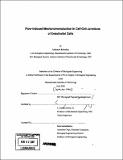| dc.contributor.advisor | C. Forbes Dewey, Jr. | en_US |
| dc.contributor.author | Rabodzey, Aleksandr | en_US |
| dc.contributor.other | Massachusetts Institute of Technology. Biological Engineering Division. | en_US |
| dc.date.accessioned | 2008-05-19T15:57:13Z | |
| dc.date.available | 2008-05-19T15:57:13Z | |
| dc.date.copyright | 2006 | en_US |
| dc.date.issued | 2006 | en_US |
| dc.identifier.uri | http://hdl.handle.net/1721.1/41586 | |
| dc.description | Thesis (Ph. D.)--Massachusetts Institute of Technology, Biological Engineering Division, 2006. | en_US |
| dc.description | Includes bibliographical references (leaves 86-92). | en_US |
| dc.description.abstract | Endothelial cells show an unexpected behavior shortly after the onset of laminar flow: their crawling speed decreases ~40% within the first 30 min, but only in a confluent monolayer of endothelial cells, not in subconfluent cultures, where cell-cell interactions are limited. This led us to study early shear effects on cell-cell adherens junctions. We found a 30±6% increase in the number of VE-cadherin molecules in the junctions. The strength of interactions of endothelial cells with surfaces coated with recombinant VE-cadherin protein also increased after laminar flow. These observations suggest that endothelial cell junction proteins respond to flow onset. The process of clustering may induce diffusion of monomers to the junction area, resulting in an overall increase in VE-cadherins in the junctions. To directly confirm the role of adherens junctions in the decrease in cell crawling speed, we used siRNA-knockdown technique to produce cells lacking VE-cadherin. These cells showed no decline in crawling speed under flow. Our interpretation is consistent with previous data on junction disassembly 8 hr after flow onset. The speed of endothelial cell crawling returns to the original level by that time, and junctional disassembly may explain that phenomenon. In order to understand better the change in VE-cadherin distribution under flow and during junction formation and remodelling, we developed a mathematical model of VE-cadherin redistribution in endothelial cells. This model allowed us to develop a quantitative framework for analysis of VE-cadherin redistribution and estimate the amount of protein in the junctions and on the apical surface. In addition to that, the model explains rapid junction disassembly in the leukocyte transmigration and junction formation in subconfluent cells. | en_US |
| dc.description.abstract | (cont.) These studies show that intercellular adhesion molecules are important in the force transmission and shear stress response. Their role, however, is not limited to flow mechanotransduction. Intercellular force transmission has an important application - organ development and, specifically, angiogenesis. We studied the role of VE-cadherin in vessel development in HUVECs and showed that VE-cadherin-null cells do not form vessels in the in vitro assay. This observation confirms the important role of intercellular force transmission in response to external force caused by flow or exerted by other cells. | en_US |
| dc.description.statementofresponsibility | by Aleksandr Rabodzey. | en_US |
| dc.format.extent | 97 leaves | en_US |
| dc.language.iso | eng | en_US |
| dc.publisher | Massachusetts Institute of Technology | en_US |
| dc.rights | MIT theses are protected by copyright. They may be viewed, downloaded, or printed from this source but further reproduction or distribution in any format is prohibited without written permission. | en_US |
| dc.rights.uri | http://dspace.mit.edu/handle/1721.1/7582 | en_US |
| dc.subject | Biological Engineering Division. | en_US |
| dc.title | Flow-induced mechanotransduction in cell-cell junctions of endothelial cells | en_US |
| dc.type | Thesis | en_US |
| dc.description.degree | Ph.D. | en_US |
| dc.contributor.department | Massachusetts Institute of Technology. Department of Biological Engineering | |
| dc.identifier.oclc | 212626616 | en_US |
